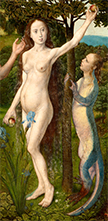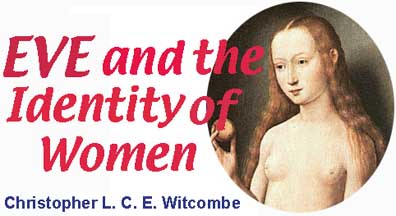|
||||
|---|---|---|---|---|

Temptation (detail)
|
5. Eve & the Serpent
In Art it is the second account of the creation of Adam and Eve (Genesis 2-3) that has received the greatest exposure. Art has thereby contributed significantly to giving the second account popular currency in Western thinking.
In contrast to the first account, where man and woman seem to have been created at the same time and on an equal footing, the second presents woman in a distinctly unfavorable light. She is made almost as an afterthought, a second solution after the first one had failed.
Concerned that man was alone and lonely in the garden, God decided to make a "helper fit for him" and brought before him "every beast of the field and every bird of the air."
It is only after Adam fails to find a suitable companion among them that God thought of creating a woman. This he accomplished, as you know, by causing Adam to fall into a deep sleep and by forming a woman out of one of his ribs. She was created specifically to serve as Adam's helper, a subordinate position that God makes clear is to be her lot in life.
On the advice of the serpent, this woman (Adam does not give her the name Eve until after the fall), disobeys God's command that neither she nor Adam eat from the tree of knowledge and consequently brings about the downfall of man and the expulsion from the garden of Eden.
In the story in Genesis 3:1-5, Eve is tempted by a creature referred to as "He" and described simply as a serpent. Its only unusual features in the story are that it could speak and presumably didn't yet crawl (it was made to crawl on its belly only after being cursed by God).
Frequently in art the serpent is represented as female. In a fresco by Michelangelo, for example, the serpent is shown with the upper body of a woman and snake-like lower parts.

female serpent
That the human part of the serpent is female is clear from the exposed left breast and from her long blond hair which streams back from her head. The human features appear to continue down as far as the knees. The impression is that her two legs become snake-like limbs just above or at the knee. The upper part of her snake-legs are wrapped around the tree, the right one coiling over the left, but below it appears that the two become one with a single tail emerging from around the tree onto the ground. Her right arm grasps the tree trunk for support as she stretches out her left arm to meet Eve's upraised left hand (the significance of the left, or "sinister", hand used in the transaction by both Eve and the serpent should not be overlooked). Michelangelo is following the popular convention of the period. A serpent with a woman's head and blond hair also appears, for example, in a fresco by Masolino of the Temptation on the entrance pilaster in the Brancacci Chapel in S. Maria del Carmine in Florence.

Temptation of Adam and Eve
By identifying Eve as a temptress (see Eve's Identity), she was seen as playing the same role as the evil serpent who had tempted her, thus linking the two. In art, the link between women and evil is made visually apparent by showing the serpent as a woman with snake-like lower parts. The image of the monstrous serpent-woman cleverly identifies both the source of evil and its nature.
6. OLD TESTAMENT, WOMEN, & EVIL
An earlier version of this essay appeared originally in Images of Women in Ancient Art
Copyright © (text only) 2000. Christopher L.C.E. Witcombe
|
|||


